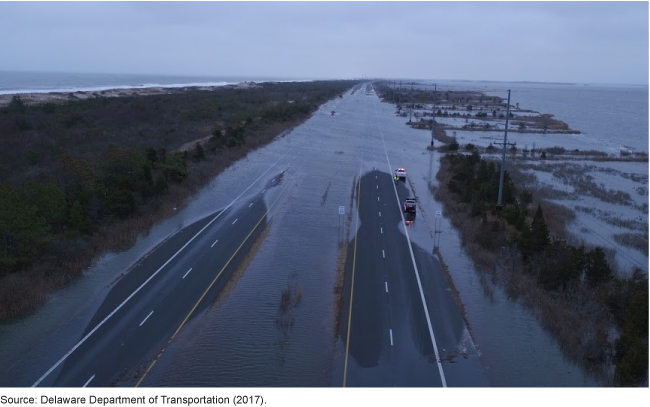Physical Infrastructure: Preliminary Observations on Options for Improving Climate Resilience of Transportation Infrastructure
Fast Facts
Climate changes threaten the U.S. transportation system, according to the National Climate Assessment. Flooding, temperature changes, etc. will have an impact on roads, ports, and more.
This testimony discusses transportation infrastructure resilience.
Information in our Disaster Resilience Framework can help agencies to address the effects of climate change, including the financial risks—an issue on our High Risk List. It discusses, for example, using incentives to encourage private companies to start risk reduction projects. The Federal Highway Administration encourages state resilience efforts with technical help, research support, and more.
Delaware has worked on resilience enhancements for its State Route 1, which routinely floods and is vulnerable to sea level rise.

Highlights
What GAO Found
GAO's Disaster Resilience Framework serves as a guide for analysis of federal actions to facilitate and promote resilience to natural disasters and changes in the climate across many policy areas, including transportation. The framework is organized around three guiding principles—information, integration, and incentives—and a series of questions that can help identify opportunities to enhance federal efforts to promote disaster resilience. Specifically, the integration principle states that integrated analysis and planning can help decision makers take coherent and coordinated actions to promote resilience. For example, in October 2019, GAO reported that no federal agency, interagency collaborative effort, or other organizational arrangement has been established to implement a strategic approach to climate resilience investment that includes periodically identifying and prioritizing projects. Such an approach could supplement individual agency climate resilience efforts and help target federal resources toward high-priority projects. GAO recommended that Congress consider establishing a federal organizational arrangement to periodically identify and prioritize climate resilience projects for federal investment.
The Federal Highway Administration (FHWA) has taken steps to encourage states to enhance the climate resilience of federally funded roads by developing agency policy, providing technical assistance to states, and supporting climate resilience research funding, among other actions. In addition, as part of ongoing work on FHWA's federal-aid highway program, GAO identified options that could further enhance the climate resilience of federally funded roads, based on a literature review and interviews with knowledgeable stakeholders (see table). Some of these options are similar to recommendations made previously by GAO. Further, according to FHWA officials, some of these options would likely require additional congressional direction or authority to implement.
Options to further enhance resilience of federally funded roads, as suggested by relevant literature and knowledgeable stakeholders
|
Option |
|
Integrate climate resilience into Federal Highway Administration policy and guidance. |
|
Update design standards to account for climate change and resilience best practices. |
|
Provide authoritative, actionable, forward-looking climate information. |
|
Add climate resilience funding eligibility requirements, conditions, or criteria to formula grant programs. |
|
Expand the availability of discretionary funding for climate resilience improvements. |
|
Alter the Emergency Relief (ER) program by providing incentives for, or conditioning funding on, pre-disaster resilience actions. |
|
Expand the availability of ER funding for post-disaster climate resilience improvements. |
|
Establish additional climate resilience planning or project requirements. |
|
Link climate resilience actions or requirements to incentives or penalties. |
|
Condition eligibility, funding, or project approval on compliance with climate resilience policy and guidance. |
Source: GAO analysis of literature and interviews with knowledgeable stakeholders. | GAO-21-561T
Why GAO Did This Study
Since 2013, GAO has included Limiting the Federal Government's Fiscal Exposure by Better Managing Climate Change Risks in its High Risk List. In addition, according to the U.S. Global Change Research Program, a changing climate threatens the performance of the U.S. transportation system across all modes, including roads. Congress authorized approximately $43 billion of fiscal year 2021 formula funding for the U.S. Department of Transportation's FHWA's federal-aid highway program, which primarily funds highway planning and construction.
This testimony discusses (1) GAO's framework for identifying opportunities to enhance the climate resilience of transportation infrastructure; and (2) preliminary observations on actions taken and options to further enhance the climate resilience of federally funded roads. This work is based on GAO reports issued from 2014 through 2019, a review of literature, and interviews conducted with FHWA officials and knowledgeable stakeholders conducted as part of on-going work. GAO expects to issue a report on the results of its ongoing work in summer 2021.
Recommendations
In the prior work on which this testimony is based, GAO made three recommendations to federal agencies and proposed one matter for congressional consideration to take steps to enhance climate-related resilience. The recommendations and matter have not been implemented as of July 2020.
